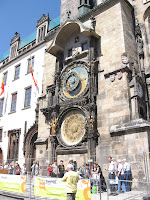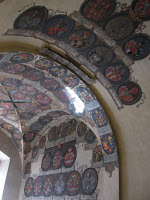 My ‘conquest’ to the east continues after spending Easter in Croatia. Over the Pentecost long weekend (10th to 12th May), three other friends and I went for a trip in the neighbouring Czech Republic. Driving was a handy option for the four of us, as the Czech Republic was not that far away (the distance between Prague and Munich is only about 400 km), petrol costs were more reasonable when shared by 4 people, and it gave us much more flexibility with where we wanted to go.
My ‘conquest’ to the east continues after spending Easter in Croatia. Over the Pentecost long weekend (10th to 12th May), three other friends and I went for a trip in the neighbouring Czech Republic. Driving was a handy option for the four of us, as the Czech Republic was not that far away (the distance between Prague and Munich is only about 400 km), petrol costs were more reasonable when shared by 4 people, and it gave us much more flexibility with where we wanted to go.今年是我的旅遊「東進年」,復活節到過克羅地亞後,我和幾個朋友上個長週末(5月10至12日)前往鄰國捷克玩了三天。由於距離不算太遠(首都布拉格離慕尼黑也是400公里左右),四人同行,駕車不但不貴,而且要往其他地方玩玩也更方便。
The 400 km drive was quite bearable as we have chosen to make a few breaks en route. After stopping at the border for money exchange and purchasing a highway sticker, we headed for the city of Plzen and spent 2 or 3 hours there. We had lunch at the famous local brewery of Pilsner Urquell and tried some ‘local cuisine’. It turned out that the food wasn’t too different from the meaty, hearty German fare, but at least the goulash was memorable as it was served in a big wholemeal bread dough and the soup went quite well with the bread. After lunch, we went for a walk in the town centre. We came across the Republic Square, reputed the largest open square in Europe, and went up the tower of the Cathedral of St. Bartholomew for a view of the whole town.
400公里的車程,中途當然要休息一下,在邊境停車找換貨幣和購買公路費標貼後,我們前往皮爾森(Plzen)逗留兩、三小時,先在當地出名的Pilsner Urquell啤酒廠吃頓午飯,地道菜式其實跟德國差不多,倒是那個盛在麫包內的匈牙利牛肉湯最有特色。之後在皮爾森市區內逛逛,走到號稱全歐洲最大的共和廣場,並登上廣場內聖伯多祿大教堂的塔頂,俯瞰全市景色。

Pilsner Urquell brewery
Pilsner Urquell啤酒廠


Secrets to a good brew 佳釀的祕訣

Goulash in a dough, certainly a creative way to serve this hearty soup.
用麫包盛匈牙利牛肉湯,賣相和創意都值得一讚。



The Republic Square (also in video clip) with the City Hall of Plzen (top right) and the Cathedral of St. Bartholomew (left).
共和廣場(左上圖及短片),及位於廣場的皮爾森市政廳(右上)和聖伯多祿大教堂(左)


The Big Synagogue, the third largest in the world.
大猶太教堂,一如其名,原來是世界第三大。
By the time we reached our hotel in Prague from Plzen, it was almost 18:00. Fortunately there was a bit more than two hours before sunset, enough time for a quick stroll in the city centre. After dinner, we headed to the Vltava river (which runs through the city centre) and managed to take in some splendid night views. The Prague Castle (Pražský Hrad) on the opposite bank of the Vltava and the Charles Bridge (Karlův Most) were the two big draw cards, and were attracting a sizeable crowd of visitors even past 23:00. It’s hard to see such a mass of people so late in the evening in big parts of Europe!
我們再度上路,差不多傍晚六點到達布拉格下塌的酒店,趁還有兩個多鐘頭才日落,趕緊乘地鐵往市區逛逛兼吃晚飯。飯後到貫穿市內的Vltava河觀看夜景,對岸小山上的布拉格城堡(Pražský Hrad)和查理大橋(Karlův Most),感引着所有遊客的照相機和腳步,十一點了,在橋上和橋附近的人潮依然,跟不少歐洲地方可不同呢。


The spanking new metro (underground railway) station near our hotel
離下塌酒店不遠,光鮮且光猛的新地鐵站


Wenceslas Square (Václavské Náměsti) 溫塞拉斯廣場



National Museum and the statue of St. Wenceslas (an important king in Czech history)
國立博物館及聖溫塞拉斯人像(溫塞拉斯是捷克史上一著名皇帝)

Tram stop? No, just a snack stop!
電車站?非也,糧水站是也。
The next morning began with our venture to the Astronomical Clock (Orlojem) at the Old Town Hall Square (Staroměstská Náměstí). The roads near the Square were all closed to traffic but the Square itself was abuzz with people and small festivities. In fact, we were coming across the Prague Marathon which had its finish line in the Square. Closer to midday, people were congregating in front of the Astronomical Clock. We decided to join them, wondering what was captivating those people. But what happened then was a let-down. Right on the dot at twelve o’clock, two windows above the clock opened and the figurines behind the windows took their turns to make a fleeting appearance before the windows closed promptly again after one minute. It simply wasn’t worth the wait!
翌日早上慕名到天文鐘(Orlojem)所在的舊市政廳廣場(Staroměstská Náměstí),但見附近的街道都禁止車輪駛入,廣場卻人山人海,原來那天舉行布拉格馬拉松,並以廣場為終點,現場也有點歌舞助興,可真熱鬧!快到中午十二點,天文鐘前聚滿了人,好像在等甚麼,我們也不甘後人,一心等到十二點正的來臨,怎料在那一刻,鐘上的兩隻小窗打開後,裡面的玩具人物祇是像走馬花燈般亮亮相,不消一分鐘後窗又再關上,究竟有甚麼令人值得花時間等候呢?真教人白等一場呀!

The Prašná Brána Tower leading to Old Town Hall Square
前往舊市政廳廣場的Prašná Brána塔


The Astronomical Clock
天文鐘



The Old Town Hall Square (Staroměstská Náměstí); see also the video below
舊市政廳廣場,亦可看以下短片


Beware of suicidal tendencies!
小心抓緊!
Our destination after lunch was the Vltava, and we followed the same route to the Charles Bridge as the previous night. While their appearances have dominated the night skies, the buildings and bridges blended in harmony again with their surroundings under the brilliant sun, the blue skies with the lush-green backdrop.
午飯後又回到Vltava河畔,沿河走到查理大橋,蔚藍的天,蒼綠的山,陽光下的景緻確與前一晚璀璨的夜景互相輝映。


National Theatre 國家劇院


The chuch at one end of the Charles Bridge
查理大橋其中一端的教堂


The bridge tower opposite to the church
教堂對面的大橋起點的塔樓

Construction of the bridge was initiated under King Charles IV of Bohemia.
下令建橋的波希米亞國皇查理四世


The Prague Castle and Charles Bridge 布拉格城堡和查理大橋


The Prague Castle by day and night 布拉格城堡的日景和夜景

St. Crucifix, one of the 30 statues on the Bridge
橋上30個塑像之一的聖十字架像
Once we’ve crossed the bridge, we went uphill towards the Prague Castle following a couple of uphill roads.
過橋後,我們便沿着一道又一道的斜路,往山上的布拉格城堡城堡進發。




The entrance to the Castle was full of visitors, and it was the same story inside. We had wanted to visit the Cathedral of St. Vitus (Katedárla sv. Vita) but the long queue leading to the Cathedral swayed us to go to other places first. But it was too late when we’ve finished touring the other parts of the Castle, because it was just about to close its doors.
城堡入口的廣場人頭湧湧,進入後也有不少遊客,單是聖維特大教堂(Katedárla sv. Vita)前便有條長長的人龍,本想參觀其他地方後才折返,但那時太晚了,教堂準備關門。


The entrance to the Prague Castle 布拉格城堡的正門
The Hradčanské Square in front of the entrance 城堡正門的廣場



The Cathedral of St. Vitus
聖維特大教堂
We went for other places of interest within the Castle, including the Old Royal Palace, St. George’s Basilica and the Golden Lane (Zlatá ulička). There was a building in the Golden Lane with an exhibition of mediaeval shields and armours along a corridor. Some of the armours came with helmets which we dubbed ‘chicken heads’ as the part covering the nose and the mouth was shaped like a beak! At the end of the corridor, we had a chance to try out our shooting skills with a crossbow. Our shooting session quickly became a live demonstration for interested on-lookers. I did a perfect job showing them what not to do …
我們參觀過城堡內其他景點,首先是舊皇宮,然後是聖喬治教堂,最有特色的要算是黃金巷(Zlatá ulička)內有一幢房子,在走廊展出歷代使用過的盾牌和盔甲,有些頭盔的鼻和嘴成尖形,猶如雀鳥的嘴,所以被我們戲稱為「雞頭」!走廊盡頭可以玩射擊,用的是(仿)中世紀的十字弓,我和另一個朋友頓時成了真人示範,我也因此可以在一眾人面前獻醜(是真的獻醜……)




The Old Royal Palace 舊皇宮

St. George’s Basilica
聖喬治教堂

The entrance to the armoury exhibition
中世紀盾牌及盔甲展的入口


Ready for mediaeval warfare? 中世紀打仗的裝備

Homicidal tendency - glad that he can't really aim!
有姿勢,無實際
Out of the Golden Lane, we passed by the Daliborka Tower which was a prison for the nobility. We walked inside to see how the prison was set up.
從黃金巷出來,經過Daliborka塔,見識裡面的中世紀監獄,當年囚禁過不少貴族階級的罪犯。



Left: a sculpture next to the tower; right: a dungeon in the tower
左:塔旁的雕塑、右:塔內的囚室
Being on top of a hill, the Prague Castle was surrounded by the views of the city, including the adjoining gardens.
由於城堡位處山上,從城堡不同地方都可看到全市景色,包括城堡毗鄰的花園。





A photo exhibition in the park
公園內的相片展覽
We still had time to kill until dinner after coming back from the Castle, so we hired a paddle boat. It was an enjoyable ride in the waters near the Charles Bridge, as the river provided an interesting viewpoint for us. Up on the hill, down in the river: that’s how we spent our full day in Prague.
下山後,趁晚飯前有空,我們便租了一艘腳踏艇,在查理橋附近的河面兜兜風,從河上回望岸上,又是另一番景色。一日內,我們上山下水,便玩了布拉格的幾大景點。




Left: The Dancing House 左:會跳舞的大廈


The National Theatre by day and night (night shot from Charles Bridge)
國家劇院(夜景從查理大橋上攝)
Comments